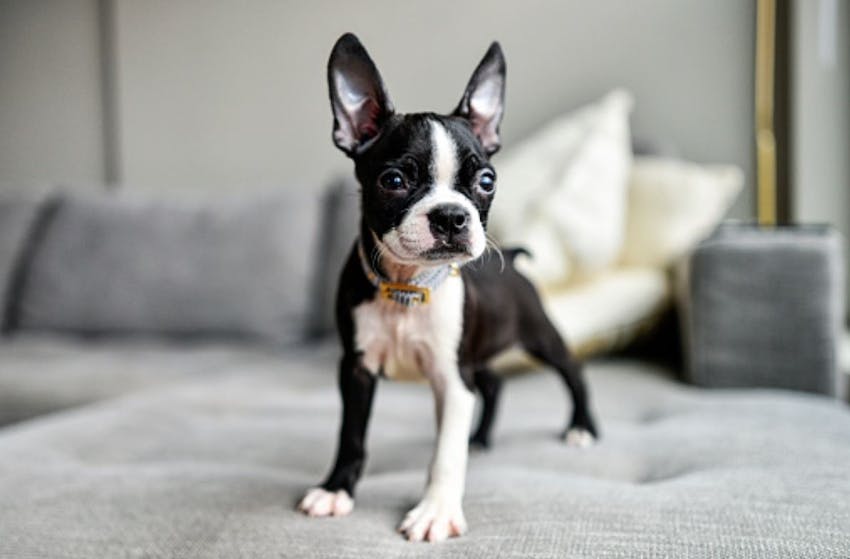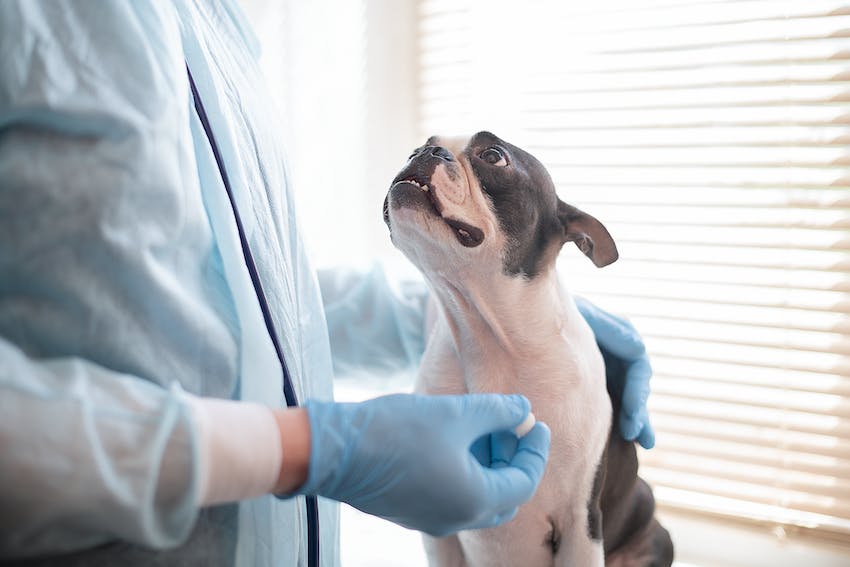Lifespan
11 to 13 years
By : Trupanion Staff | Updated May 2, 2024
Lifespan
11 to 13 years
Measuring between 12 to 17 inches tall at the shoulder, Boston Terriers have three different weight classes:
Under 15 pounds
15 - 20 pounds
20 - 25 pounds
Energy level
Mall Walker
Breed Group
Non-Sporting

There’s a reason the Boston Terrier is known as the American Gentleman. Not only does this pup sport a dapper, tuxedoed look, but they are friendly, sociable, and have a charm that evokes East Coast sophistication. Created from crossing bulldog and terrier breeds, Bostons have inherited the more mellow bulldog temperament with the athleticism terriers are known for, making for an energetic companion dog. They love to play and are always willing to be co-pilot on their human's adventures.
As their name suggests, the Boston Terrier breed was developed in Boston, Massachusetts. As pit fighting became less popular in England and the United States, dog fanciers began crossing bulldog and terrier breeds in an effort to create a smaller companion dog.
In 1870, a Bostonian named Robert C. Hooper bought a dog
named Judge from a friend. Judge was a cross between a Bulldog and a white English Terrier (a now extinct
breed) and became known as Hooper’s Judge. Judge was the base for the Boston Terrier breed, and all Boston
Terrier puppies can trace their lineage back to him. The breed carries on his white markings on the face and
the more even mouth compared to other bulldog breeds.
Through selective and carefully recorded breeding, the Boston Terrier breed was standardized very quickly compared to other breeds. Fanciers of the dog nicknamed them “roundheads” and formed the American Bull Terrier Club in 1889, but changed the name in 1893 after confusion between breeds with similar names to the Boston Terrier Club. That same year the breed was recognized by the American Kennel Club — the first breed created in the United States to be recognized. While their name might include terrier, they aren’t a part of the terrier breed group. In fact, they were the first breed to be included in AKC’s Non-Sporting group.
Boston Terriers are bred as a perfect sidekick. As companion dogs, they have the energy to keep up on most adventures, but also enjoy just lazing around on your lap. Their temperament makes them a frequent choice for therapy dogs as long as they have been properly socialized and positively exposed to different environments as puppies. Some Bostons can become protective of their owners, so early and continued socialization throughout life is important. A Boston has ratter genes, so you might notice some instinctual predisposition for chasing squirrels and other squeaky things — this makes them ideal candidates for playing fetch or tug!

While Boston Terriers are known for their outgoing and social nature, proper proactive exposure to new sights, sounds, people, dogs, and other animals as a young puppy is essential for their socialization skills.
Bostons are a frequent breed choice for families with children. They’re outgoing, rugged, and can tolerate the physical handling of young kids even though they are a smaller breed. Make sure they have been properly introduced and socialized with children as a young puppy to set them up for success. Young children and dogs should always be supervised, and it’s helpful for a dog to have their own “safe space” where they can go when they need some quiet time.
When it comes to animal buddies in the home, it’s once again, all about socialization. As long as they have been properly socialized and introduced, Boston Terriers can enjoy and benefit from the companionship of other animals.
Boston Terriers are one of the higher energy companion dogs, but while they need consistent exercise, it
doesn’t take too much. A twice-daily walk paired with some play are usually enough to keep a Boston happy
and healthy.
Mental enrichment is important for Boston Terriers, not only to keep them entertained but also to help prevent separation anxiety. Stimulate their brains by teaching new tricks, attending obedience classes, joining a dog sport, and providing dog puzzles and interactive toys. Boston Terriers are super smart, so mixing up their toys and puzzles will keep them on their toes and always learning.
Boston Terriers sometimes take to house training slower than other breeds, though most get the hang of it by six to nine months of age. Because Bostons love their humans so much, they are prone to separation anxiety if they aren’t taught at a young age that being away from their human is nothing to worry about. Spending some time on this potential problem early on will save you and your Boston many anxious days.
Boston Terriers do well in many different dog sports, and especially enjoy activities where they work in tandem with their human:
Boston Terriers sport a short, smooth coat and come in three colors: Black, brindle, and seal — all with white on the face and chest which give them their dapper tuxedoed look. The seal color appears black, but when under bright light or sunlight has a reddish tint. A Boston’s coat doesn’t provide much insulation and it’s important to keep them warm in colder temperatures with a jacket or sweater.
Boston Terriers need weekly brushing, which helps evenly distribute the natural oils in their coat and remove any dirt and shedding fur. Occasional bathing is recommended only when a Boston gets dirty or seems extra stinky. Take care to not overwash and strip the coat of its natural oils. A Boston’s face wrinkles should be kept clean and dry, to keep the yeast and bacterial populations in check and prevent uncomfortable and recurrent infections. Introduce your puppy to the grooming experience from a young age to create a positive association and encourage a calm and relaxing “spaw” treatment.
The Boston Terrier is a brachycephalic dog breed. Years of breeding based on appearances have resulted in the dog having a shorter-than-normal snout, which can cause breathing difficulties and lead to long-lasting health conditions. It's important to keep Boston Terriers current on their veterinary care to help catch issues early. In some cases, surgery may help improve your dog's breathing.
Even with healthy dogs, it's important to take preventative steps. Never exercise them in warmer temperatures or when it’s humid outside, and provide lots of breaks and water. Bostons, like all flat-faced breeds, should always be monitored for heat stroke symptoms, which often include: heavy panting, drooling, bright red tongue or gums, rapid pulse, and wide, panicked eyes.

Friendly and spunky, Boston Terriers have been popular in media and culture for years.
Sergeant Stubby, a heroic and very good boy, may have been the most decorated canine in World War 1, and was the only dog to have been nominated to have a rank, and was then promoted for his acts in the line of duty.
nbsp;